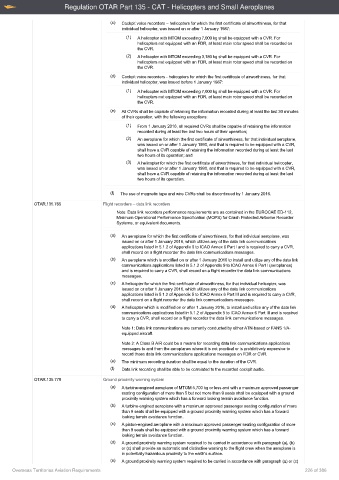Page 226 - Overseas Territories Aviation Requirements Consolidated - Total AOC
P. 226
Regulation OTAR Part 135 - CAT - Helicopters and Small Aeroplanes
(c) Cockpit voice recorders – helicopters for which the first certificate of airworthiness, for that
individual helicopter, was issued on or after 1 January 1987:
(1) A helicopter with MTOM exceeding 7,000 kg shall be equipped with a CVR. For
helicopters not equipped with an FDR, at least main rotor speed shall be recorded on
the CVR.
(2) A helicopter with MTOM exceeding 3,180 kg shall be equipped with a CVR. For
helicopters not equipped with an FDR, at least main rotor speed shall be recorded on
the CVR.
(d) Cockpit voice recorders - helicopters for which the first certificate of airworthiness, for that
individual helicopter, was issued before 1 January 1987:
(1) A helicopter with MTOM exceeding 7,000 kg shall be equipped with a CVR. For
helicopters not equipped with an FDR, at least main rotor speed shall be recorded on
the CVR.
(e) All CVRs shall be capable of retaining the information recorded during at least the last 30 minutes
of their operation; with the following exceptions:
(1) From 1 January 2016, all required CVRs shall be capable of retaining the information
recorded during at least the last two hours of their operation;
(2) An aeroplane for which the first certificate of airworthiness, for that individual aeroplane,
was issued on or after 1 January 1990, and that is required to be equipped with a CVR,
shall have a CVR capable of retaining the information recorded during at least the last
two hours of its operation; and
(3) A helicopter for which the first certificate of airworthiness, for that individual helicopter,
was issued on or after 1 January 1990, and that is required to be equipped with a CVR,
shall have a CVR capable of retaining the information recorded during at least the last
two hours of its operation.
(f) The use of magnetic tape and wire CVRs shall be discontinued by 1 January 2016.
OTAR.135.765 Flight recorders – data link recorders
Note: Data link recorders performance requirements are as contained in the EUROCAE ED-112,
Minimum Operational Performance Specification (MOPS) for Crash Protected Airborne Recorder
Systems, or equivalent documents.
(a) An aeroplane for which the first certificate of airworthiness, for that individual aeroplane, was
issued on or after 1 January 2016, which utilizes any of the data link communications
applications listed in 5.1.2 of Appendix 9 to ICAO Annex 6 Part I and is required to carry a CVR,
shall record on a flight recorder the data link communications messages.
(b) An aeroplane which is modified on or after 1 January 2016 to install and utilize any of the data link
communications applications listed in 5.1.2 of Appendix 9 to ICAO Annex 6 Part I (aeroplanes)
and is required to carry a CVR, shall record on a flight recorder the data link communications
messages.
(c) A helicopter for which the first certificate of airworthiness, for that individual helicopter, was
issued on or after 1 January 2016, which utilizes any of the data link communications
applications listed in 5.1.2 of Appendix 5 to ICAO Annex 6 Part III and is required to carry a CVR,
shall record on a flight recorder the data link communications messages.
(d) A helicopter which is modified on or after 1 January 2016, to install and utilize any of the data link
communications applications listed in 5.1.2 of Appendix 5 to ICAO Annex 6 Part III and is required
to carry a CVR, shall record on a flight recorder the data link communications messages.
Note 1: Data link communications are currently conducted by either ATN-based or FANS 1/A-
equipped aircraft.
Note 2: A Class B AIR could be a means for recording data link communications applications
messages to and from the aeroplanes where it is not practical or is prohibitively expensive to
record those data link communications applications messages on FDR or CVR.
(e) The minimum recording duration shall be equal to the duration of the CVR.
(f) Data link recording shall be able to be correlated to the recorded cockpit audio.
OTAR.135.770 Ground proximity warning system
(a) A turbine-engined aeroplane of MTOM 5,700 kg or less and with a maximum approved passenger
seating configuration of more than 5 but not more than 9 seats shall be equipped with a ground
proximity warning system which has a forward looking terrain avoidance function.
(b) A turbine-engined aeroplane with a maximum approved passenger seating configuration of more
than 9 seats shall be equipped with a ground proximity warning system which has a forward
looking terrain avoidance function.
(c) A piston-engined aeroplane with a maximum approved passenger seating configuration of more
than 9 seats shall be equipped with a ground proximity warning system which has a forward
looking terrain avoidance function.
(d) A ground proximity warning system required to be carried in accordance with paragraph (a), (b)
or (c) shall provide an automatic and distinctive warning to the flight crew when the aeroplane is
in potentially hazardous proximity to the earth’s surface.
(e) A ground proximity warning system required to be carried in accordance with paragraph (a) or (c)
Overseas Territories Aviation Requirements 226 of 386

